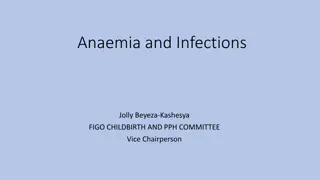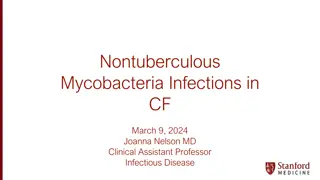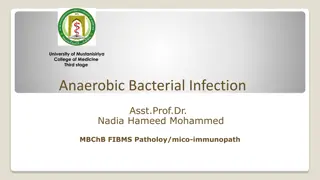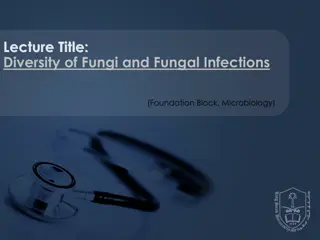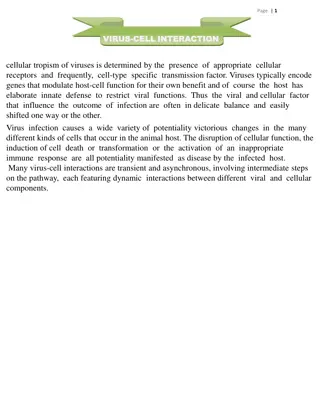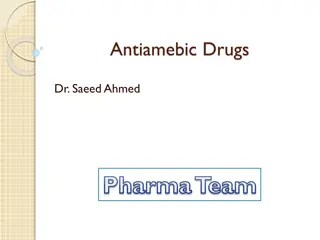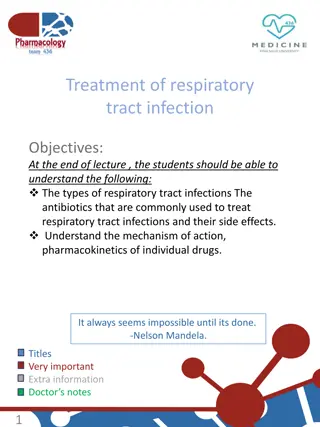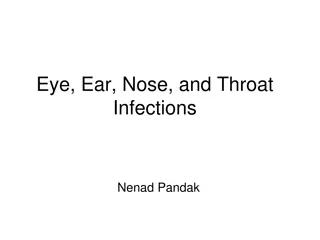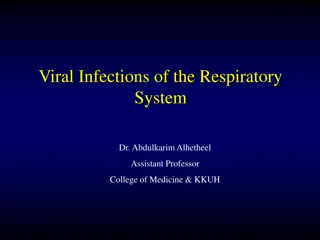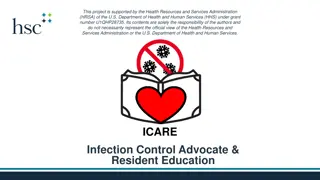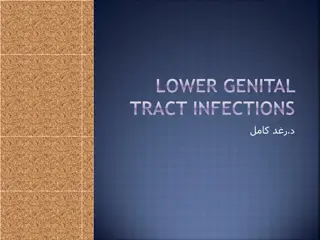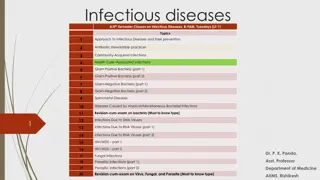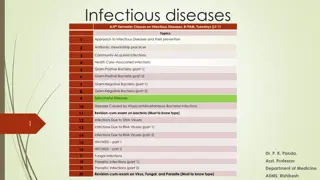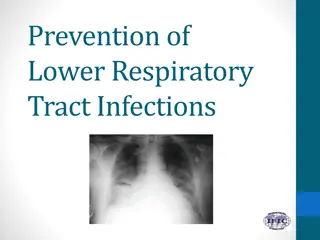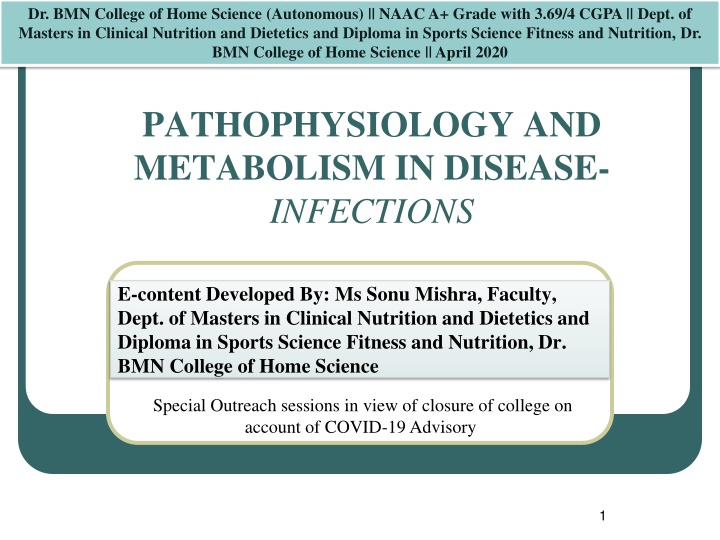
Pathophysiology and Transmission of Infectious Diseases
Learn about the role of microorganisms in infectious diseases, reasons for increased deaths from infections, and the chain of transmission. Explore factors related to infectious agents and how they enter and spread within the body.
Download Presentation

Please find below an Image/Link to download the presentation.
The content on the website is provided AS IS for your information and personal use only. It may not be sold, licensed, or shared on other websites without obtaining consent from the author. If you encounter any issues during the download, it is possible that the publisher has removed the file from their server.
You are allowed to download the files provided on this website for personal or commercial use, subject to the condition that they are used lawfully. All files are the property of their respective owners.
The content on the website is provided AS IS for your information and personal use only. It may not be sold, licensed, or shared on other websites without obtaining consent from the author.
E N D
Presentation Transcript
Dr. BMN College of Home Science (Autonomous) || NAAC A+ Grade with 3.69/4 CGPA || Dept. of Masters in Clinical Nutrition and Dietetics and Diploma in Sports Science Fitness and Nutrition, Dr. BMN College of Home Science || April 2020 PATHOPHYSIOLOGY AND METABOLISM IN DISEASE- INFECTIONS E-content Developed By: Ms Sonu Mishra, Faculty, Dept. of Masters in Clinical Nutrition and Dietetics and Diploma in Sports Science Fitness and Nutrition, Dr. BMN College of Home Science Special Outreach sessions in view of closure of college on account of COVID-19 Advisory 1
INTRODUCTION Microorganisms, namely bacteria, viruses, fungi and parasites, are present everywhere in the soil, water, atmosphere and on the body surfaces, and are responsible for a large number of infectious diseases in human beings Vaccines have, however, been successful in controlling or eliminating some diseases all over the world However, infections still rank very high as a cause of death in the world. 2
REASONS OF DEATH FROM INFECTIONS Development of newer and antibiotic-resistant strains of microorganisms Administration of immunosuppressive therapy to patients with malignant tumours and transplanted organs making them susceptible to opportunistic infections Increasing number of patients reporting to hospital for different illnesses but instead many developing hospital acquired infections. 3
CHAIN IN TRANSMISSION OF INFECTIOUS DISEASE i) Reservoir of pathogen. Infection occurs from the source of reservoir of pathogen. It may be a human being (e.g. in influenza virus), animal (e.g. dog for rabies), insect (e.g. mosquito for malaria), or soil (e.g. enterobiasis) ii) Route of infection. Infection is transmitted from the reservoir to the human being by different routes, usually from breach in the mucosa or the skin In general, the organism is transmitted to the site where the organism would normally flourish e.g. N. gonorrhoeae usually inhabits the male and female urethra and, therefore, the route of transmission would be sexual contact. iii) Mode of transmission. The organism may be transmitted directly by physical contact or by faecal contamination (e.g. spread of eggs in hookworm infestation), or indirectly by fomites (e.g. insect bite). iv) Susceptible host. The organism would colonise the host if the host has good immunity but such a host can pass on infection to others. However, if the host is old, debilitated, malnourished, or immunosuppressed due any etiology, he is susceptible to have manifestations of infection 4
FACTORS RELATING TO INFECTIOUS AGENTS 1. Mode of entry. Microorganisms causing infectious diseases may gain entry into the body by various routes e.g. through ingestion (external route); by direct contact (contagious infection); and by contaminated water, food, soil, environment or from an animal host (zoonotic infections) 2. Spread of infection. Microorganisms after entering the body may spread further through the phagocytic cells, blood vessels and lymphatics 3. Production of toxins. Bacteria liberate toxins which have effects on cell metabolism. Endotoxins are liberated on lysis of the bacterial cell while exotoxins are secreted by bacteria and have effects at distant sites too. 5
FACTORS RELATING TO INFECTIOUS AGENTS 4. Virulence of organisms. Many species and strains of organisms may have varying virulence e.g. the three strains of C. diphtheriae (gravis, intermedius and mitis) produce the same diphtherial exotoxin but in different amounts. 5. Product of organisms. Some organisms produce enzymes that help in spread of infections e.g. hyaluronidase by Cl. welchii, streptokinase by streptococci, staphylokinase and coagulase by staphylococci 6
FACTORS RELATING TO HOST Microorganisms invade human body when defenses are not adequate. These factors include the following: 1. Physical barrier. A break in the continuity of the skin and mucous membranes allows the microorganisms to enter the body. 2. Chemical barrier. Mucus secretions of the oral cavity and the alimentary tract and gastric acidity prevent bacterial colonisation. 3. Effective drainage. Natural passages of the hollow organs like respiratory, gastrointestinal, urinary and genital system provide a way to drain the excretions effectively. Obstruction in any of these passages promotes infection. 4. Immune defense mechanisms- if the immune system is poor then susceptibility of infection increases 7
DISEASES CAUSED BY BACTERIA In order to gain an upper hand in human host, bacteria must resist early engulfment by neutrophils. They survive and damage the host in a variety of ways such as by generation of toxins (e.g. gas-forming anaerobes), by forming a slippery capsule that resists attachment to macrophages (e.g. pneumococci), by inhibition of fusion of phagocytic vacuoles with lysosomes (e.g. tubercle bacilli) etc. 8
EXAMPLES WHOOPING COUGH (PERTUSSIS) Whooping cough is a highly communicable acute bacterial disease of childhood caused by Bordetella pertussis. The use of DPT vaccine has reduced the prevalence of whooping cough in different populations. GRANULOMA INGUINALE Granuloma inguinale is a sexually- transmitted disease affecting the genitalia and inguinal and perianal regions caused by Calymmatobacterium donovani. The disease is common in tropical and subtropical countries such as New Guinea, Australia and India. STAPHYLOCOCCAL INFECTIONS Staphylococci are gram-positive cocci which are present everywhere in the skin, umbilicus, nasal vestibule, stool etc. Three species are pathogenic to human beings: Staph. aureus, Staph. epidermidis and Staph. saprophyticus. Most staphylococcal infections are caused by Staph. aureus. Staphylococcal infections are among the commonest antibiotic-resistant hospital- acquired infection in surgical wounds 9
STREPTOCOCCAL INFECTIONS Streptococci are also gram-positive cocci but unlike staphylococci, they are more known for their nonsuppurative autoimmune complications than suppurative inflammatory responses TETANUS. Tetanus or lock jaw is a severe acute neurologic syndrome caused by tetanus toxin, tetanospasmin, which is a neurotoxic exotoxin elaborated by C. tetani. The spores of the microorganism present in the soil enter the body through a penetrating wound BOTULISM. Botulism is characterised by symmetric paralysis of cranial nerves, limbs and trunk. The condition occurs following ingestion of food contaminated with neurotoxins of C. botulinum and less often by contamination of a penetrating wound4 CLOSTRIDIAL FOOD POISONING. Clostridial food poisoning is caused by enterotoxin elaborated by C. perfringens. Out of five serotypes of C. perfringens, type A and C produce alpha-enterotoxin that causes food poisoning. 10
DISEASES CAUSED BY FUNGI Of the large number of known fungi, only a few are infective to human beings. Many of the human fungal infections are opportunistic i.e. they occur in conditions with impaired host immune mechanisms. CANDIDIASIS is an opportunistic fungal infection caused most commonly by Candida albicans and occasionally by Candida tropicalis. In human beings, Candida species are present as normal flora of the skin and mucocutaneous areas, intestines and vagina. The organism becomes pathogenic when the balance between the host and the organism is disturbed SUPERFICIAL MYCOSIS Dermatophytes are the most important example of cutaneous mycosis caused by Microsporum, Trichophyton and Epidermophyton. These superficial fungi are spread by direct contact or by fomites and infect tissues such as the skin, hair and nails 11
DISEASES CAUSED BY VIRUSES Viral diseases are the most common cause of human illness. However, many of the viral infections remain asymptomatic while others produce viral disease Dengue Haemorrhagic Fever (DHF) The word dengue is derived from African word denga meaning fever with haemorrhages. Dengue is caused by virus transmitted by bites of mosquito Aedes aegypti Chikungunya virus infection is primarily a disease in nonhuman primates but the infection is transmitted to humans by A. aegypti mosquito. The disease is endemic in parts of Africa and Asia INFLUENZA VIRUS INFECTIONS Influenza virus infection is an important and common form of communicable disease, especially prevalent as a seasonal infection in the developed countries. Its general clinical features range from a mild afebrile illness similar to common cold by appearance of sudden fever, headache, myalgia, malaise, chills and respiratory tract manifestations such as cough, soar throat 12
Bird Flu ((Influenza A/H5N1) H5N1 subtype of the influenza type A virus infection causes severe acute respiratory syndrome (SARS) which is the human form of bird flu or avian influenza with having similar symptomatology Swine Flu (Influenza A/H1N1) H1N1 influenza type A flu which appeared last in 1977-78 as a mild form of pandemic has reappeared in April 2009 as an outbreak in Mexico but is rapidly spreading elsewhere. H1N1 influenza type A virus is primarily an infection in pigs with low mortality in them. Human beings acquire infection by direct contact with infected pigs. Varicella zoster virus is a member of herpes virus family and causes chickenpox (varicella) in non-immune individuals and herpes zoster (shingles) in those who had chickenpox in the past. Rabies is a fatal form of encephalitis in humans caused by rabies virus. The virus is transmitted into the human body by a bite by infected carnivores e.g. dog, wolf, fox and bats 13
DISEASES CAUSED BY PARASITES AMOEBIASIS Amoebiasis is caused by Entamoeba histolytica, named for its lytic action on tissues. It is the most important intestinal infection of man. The condition is particularly more common in tropical and subtropical areas with poor sanitation MALARIA Malaria is a protozoal disease caused by any one or combination of four species of plasmodia. These parasites are transmitted by bite of female Anopheles mosquito CYSTICERCOSIS is infection by the larval stage of Taenia solium, the pork tapeworm. The adult tapeworm resides in the human intestines. The eggs are passed in human faeces which are ingested by pigs or they infect vegetables. These eggs then develop into larval stages in the host, spread by blood to any site in the body and form cystic larvae termed cysticercus cellulosae 14
TORCH COMPLEX Acronym TORCH complex refers to development of common complex of symptoms in infants due to infection with different microorganisms that include: Toxoplasma, Others, Rubella, Cytomegalovirus, and Herpes simplex virus; category of Others refers to infections such as hepatitis B, coxsackievirus B, mumps and poliovirus. The infection may be acquired by the foetus during intrauterine life, or perinatally and damage the foetus or infant All the microorganisms in the TORCH complex are transmitted transplacentally and, therefore, infect the foetus from the mother. 15

